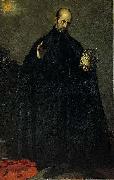Wholesale Oil Painting No Minimum |
|||||||||||
|
|
|||||||||||

|
|||||||||||
|
|
|
||||||||
Cano, AlonsoSpanish, 1601-67 Spanish painter, sculptor and architect. He was an artist of rare versatility in 17th-century Spain, although his architectural work was not extensive. While he is also known for his drawings, only about 60 of these are definitely attributable to him, despite the many extant sketches with the name 'Cano' carelessly added by later hands. Unlike most of his Spanish contemporaries, such as Zurbaren or Velezquez, whose artistic styles did not outlive them, Cano's artistic legacy is measured in part by the number of artists who trained in his workshop and went on to become important masters in their own right: the painters Pedro Atanasio Bocanegra, Juan de Sevilla (1643-95) and, more distantly, Jos Risueo, and the sculptors Pedro de Mena and Jos de Mora, |
||||||||
|
|
||||||||
San Francisco de Borja
San Francisco de Borja Painting ID:: 67695 |
San Francisco de Borja (Saint Francis Borgia), oil on canvas, 189 x 123 cm.
San Francisco de Borja (Saint Francis Borgia), oil on canvas, 189 x 123 cm. |
|||||||
|
|
||||||||
|
Alonso Cano (19 March 1601 - 3 September 1667) was a Spanish painter, architect and sculptor born in Granada. He learned architecture from his father, Miguel Cano; painting in the academy of Juan del Castillo, and from Francisco Pacheco the teacher of Velezquez; and sculpture from Juan Martenez Montañ's. As a sculptor, his most famous works are the Madonna and Child in the church of Lebrija (also called Nebrija), and the colossal figures of San Pedro and San Pablo. He was made first royal architect, painter to Philip IV, and instructor to the prince, Balthasar Charles, Prince of Asturias.The King gave him the church preferment of a canon of the Granada Cathedral (1652), in order to take up a position as chief architect of the cathedral, where his main achievement in architecture was the façade, designed at the end of his life and erected to his design after his death. Ideal portrait of a Spanish King.He was notorious for his ungovernable temper; and it is said that once he risked his life by committing the then capital offence of dashing to pieces the statue of a saint, when in a rage with the purchaser who begrudged the price he demanded. According to another story, he found his house robbed after coming home one evening, his wife murdered, and his Italian servant fled. Notwithstanding the presumption against the fugitive, the magistrates condemned Cano, because he was of a jealous temper. Upon this he fled to Valencia, but afterwards returned to Madrid, where he was put to the torture, which he endured without incriminating himself, and the king received him into favour. After the death of his wife he took Holy Orders as a protection from farther prosecution, but still continued his professional pursuits. He died in 1676. In his last moments, when the priest held to him a crucifix, he told him to take it away; according to the Catholic Encyclopedia, this was because the priest gave the Sacrament to conversos. San Francisco de Borja San Francisco de Borja (Saint Francis Borgia), oil on canvas, 189 x 123 cm. 1624(1624) |
||||||||
|
|
||||||||
|
Prev Next
|
||||||||
|
|
||||||||
|
Related Paintings to Alonso Cano :. |
||||||||
|
|
||||||||
|
CONTACT US |

